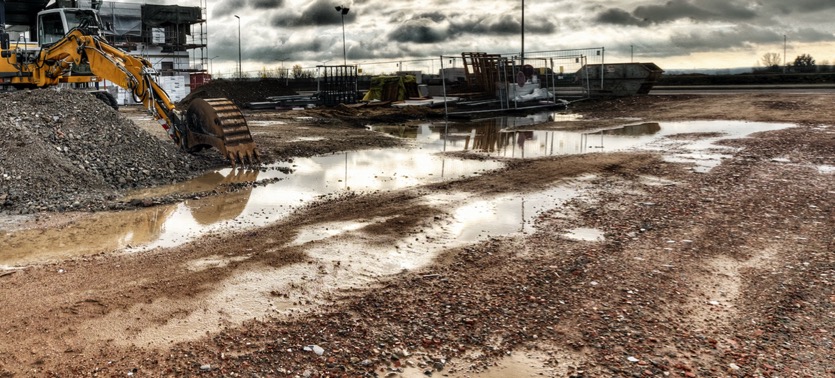Making the Most of Bad Weather

Weather – it can make or break the progress of a job. The effects of weather can completely alter the course of a landscape construction project. It can impact employee management, material costs, equipment repair expenses, client relations – basically, anything involved in the construction process. It can even be the difference between making a profit on a project or losing money. To say the least, making the most of bad weather situations is a constant struggle in the landscape industry. Following are some tips to maintain productivity and profit in adverse weather conditions.
Educate Your Customers
One of the most important methods of staying ahead of bad weather issues is to educate your clients on the impact weather can have on their outdoor project. Homeowners need to be prepared for the distinct possibility that it may rain seven days in a row, for instance, turning an estimated three-week job into a four-week job. But more important than possible timeline changes are the severe effects weather can have on the integrity of the project. For example, the collapsing of excavated swimming pool walls after excessive rain.
Some ways to educate your clients on the effects of weather on their project include:
- Provide customers with educational literature before work on the project starts. This will help inform them of the severe consequences adverse weather can have on their project.
- Create a video illustrating the negative effects of weather on projects like theirs and how your company is prepared to handle them.
- Share information specific to their type of project, and personalize it, so your clients understand your knowledge of weather effects on their particular job.
- Explain your business’ methods of working around bad weather circumstances, like working on weekends, preparing a jobsite for a storm, etc.
- Always emphasize that, yes, getting the project done on time is important, but making sure the job is safe and secure during construction—and that it will stand the test of time once complete—is crucial.
When consumers were asked in a survey for the number one thing they considered when making a referral, 73 percent answered, “I trust they will do a good job.” Putting in the extra effort to educate your customers ahead of time about the impacts of weather on their project helps generate the necessary trust in your company. This trust is crucial to transforming a well-executed project into a referral.
Stay in Contact
Once your customers have been sufficiently educated about the dangers of weather for their project, it is essential that you stay in frequent contact with them. Keeping them informed about how the weather will be affecting their job before and during the course of the project is vitally important. You don’t want clients calling you up because they expected a whole team on the job one day, but when they looked out the window they saw no one there.
Here are a few ways to keep your customers in the loop about adverse weather conditions:
- Many successful landscaping companies incorporate up-to-the-minute weather monitoring systems into their arsenal of tools. If this is you, tell your client up front that your company uses top-of-the-line technology to stay informed about inclement weather.
- After paying attention to the weather forecast, send an alert to those clients with open projects the day before the team is expected onsite. Let them know about the possibility of bad weather which may affect working conditions.
- Once you have made the decision to call off your team for the day, let your customers know immediately, so that they are not left waiting for your crew to show up.
- Utilize social media platforms like Facebook and Twitter to keep clients up to date on how the weather will affect progress. This provides a forum where customers can ask you questions about more than just weather conditions. Potential clients can see these as well, letting them know how actively you stay in contact with your customers.
- Use social media to manage the “domino effect.” When one job is delayed, subsequently future jobs become delayed, too. Social media is a quick and convenient way to inform clients with scheduled jobs about the effects of the delay on their projects.
PRO TIP: 29 percent of referrals come from social media. By staying in frequent contact with your customers on social media, you showcase to potential clients that your business goes the extra mile to get projects done in a safe, timely manner.
Stay Productive
Even if you cannot get your crew out on the job due to bad weather, there are plenty of other things you can do to keep your business running even smoother once you get back out on the site.
Think long term
Many businesses will take advantage of bad weather days by “putting out fires,” catching up on paperwork, or making a social media post or two. This is a great start. But rather than coming up with a short-term fix for everyday tasks like bookkeeping and marketing, consider new ways to accomplish these one-at-a-time tasks faster and in bulk.
For example, use a rain-day to train a member of your team to schedule Facebook posts in advance, rather than posting them individually. Look into content management systems like Hootsuite or Buffer to schedule posts across social media platforms. Thinking and acting long-term about day-to-day tasks provides more flexibility for larger task management on both good and bad weather days.
Equipment maintenance
Once summer is in full swing, finding an entire day to commit to equipment upkeep is impossible. Rainy days are the perfect time to dig in and inspect all your equipment. You may notice something that needs attention on a skid steer or excavator required full-time on projects, that can easily be fixed. Don’t end up wasting money and labor on something small that breaks on a jobsite that could have been avoided by taking advantage of extra time during bad weather.
Related Read: Let Equipment Supercharge your Productivity
Client relations
Relevance is one of the hardest things to maintain in the design/build industry. Bad weather days are the perfect time to stay in the office and work on building necessary relationships with your other customers. Send a quick email to a client whose job you recently completed, and check in on how they are enjoying the newest additions to their landscape. Maybe send a survey to find out from trusted customers what they think you are doing right and what you can improve upon. These methods demonstrate to your current and past customers that you do not stop working for them, even if you cannot be out on the job site.
Brainstorm
Just because the crew is not working onsite does not mean you should let them get rusty. Take this opportunity to sit down with your team and brainstorm about ways you can improve your field production; or you can highlight new installation practices that could be integrated in their work. Maybe you are planning to offer a new service to your customers in the near future; bad weather days might be a good time to introduce it to your employees. Perhaps you acquired a new mini-excavator or demo saw and would like to offer a workshop on how to operate it properly. Or maybe one of your crew members heard about a new project management system that is simpler than the one your company uses now.
Conversations like these are necessary for your business to run smoothly, and after one rainy day, your crew will have the confidence to get back on the job site with the efficiency of a well-oiled machine. Plus, these conversations would normally take place after work hours on a nice day. So, by brainstorming on a rainy day, you can communicate all the necessary information to your crew members in fewer overtime hours.
Do Something About it NOW
It’s easy to brush off being productive on a rainy day by saying, “Well, that’s the way this business goes.” But if you do something about it now, it will help your business flourish in the future.







